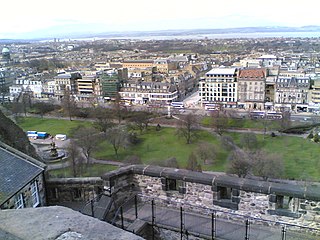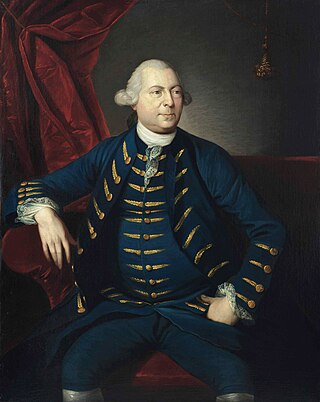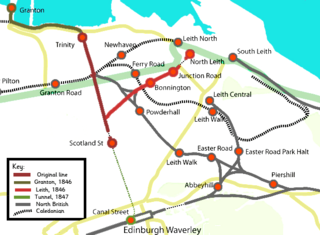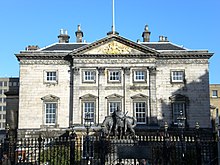
Henry Dundas, 1st Viscount Melville, PC, FRSE, styled as Lord Melville from 1802, was the trusted lieutenant of British prime minister William Pitt and the most powerful politician in Scotland in the late 18th century.
Princes Street is one of the major thoroughfares in central Edinburgh, Scotland and the main shopping street in the capital. It is the southernmost street of Edinburgh's New Town, stretching around 1.2 km from Lothian Road in the west, to Leith Street in the east. The street has few buildings on the south side and looks over Princes Street Gardens allowing panoramic views of the Old Town, Edinburgh Castle, as well as the valley between. Most of the street is limited to trams, buses and taxis with only the east end open to all traffic.

Edinburgh Waverley railway station is the principal railway station serving Edinburgh, Scotland. It is the second busiest station in Scotland, after Glasgow Central. The station serves as the northern terminus of the East Coast Main Line, 393 miles 13 chains from London King's Cross, although some trains operated by London North Eastern Railway continue to other Scottish destinations beyond Edinburgh.

Princes Street Gardens are two adjacent public parks in the centre of Edinburgh, Scotland, lying in the shadow of Edinburgh Castle. The Gardens were created in the 1820s following the long draining of the Nor Loch and building of the New Town, beginning in the 1760s.

This article is a timeline of the history of Edinburgh, Scotland, up to the present day. It traces its rise from an early hill fort and later royal residence to the bustling city and capital of Scotland that it is today.

The New Town is a central area of Edinburgh, the capital of Scotland. It was built in stages between 1767 and around 1850, and retains much of its original neo-classical and Georgian period architecture. Its best known street is Princes Street, facing Edinburgh Castle and the Old Town across the geological depression of the former Nor Loch. Together with the West End, the New Town was designated a UNESCO World Heritage Site alongside the Old Town in 1995. The area is also famed for the New Town Gardens, a heritage designation since March 2001.

Edinburgh is a major transport hub in east central Scotland and is at the centre of a multi-modal transport network with road, rail and air communications connecting the city with the rest of Scotland and internationally.

Granton is a district in the north of Edinburgh, Scotland. Granton forms part of Edinburgh's waterfront along the Firth of Forth and is, historically, an industrial area having a large harbour. Granton is part of Edinburgh's large scale waterfront regeneration programme.

Sir Lawrence Dundas, 1st Baronet was a Scottish merchant, politician and planter.

The Royal Bank of Scotland plc is a major retail and commercial bank in Scotland. It is one of the retail banking subsidiaries of NatWest Group, together with NatWest and Ulster Bank. The Royal Bank of Scotland has around 700 branches, mainly in Scotland, though there are branches in many larger towns and cities throughout England and Wales. The bank is completely separate from the fellow Edinburgh-based bank, the Bank of Scotland, which pre-dates the Royal Bank by 32 years. The Royal Bank of Scotland was established to provide a bank with strong Hanoverian and Whig ties.

Leith Walk is one of the longest streets in Edinburgh, Scotland, and is the main road connecting the east end of the city centre to Leith.

The Edinburgh, Leith and Newhaven Railway was a railway company formed in 1836 to connect the city of Edinburgh with the harbours on the Firth of Forth. When the line connected to Granton, the company name was changed to the Edinburgh, Leith and Granton Railway. It opened part of its route in 1846, but reaching the centre of Edinburgh involved the difficult construction of a long tunnel; this was opened in 1847. It was on a steep incline and was worked by rope haulage.

John Dick Peddie was a Scottish architect, businessman and a Liberal Party politician.

Dundas House is a Neoclassical building in Edinburgh, Scotland. It is located at 36 St Andrew Square, in the city's first New Town. The building was completed in 1774 as a private town house for Sir Lawrence Dundas by the architect Sir William Chambers. Much altered internally and extended over the years, today it is the registered office of the Royal Bank of Scotland and its parent, NatWest Group and is protected as a category A listed building.
The Royal Bank of Scotland £50 note is a sterling banknote. It is the second largest denomination of banknote issued by the Royal Bank of Scotland. The current polymer note, first issued in 2021 bears an image of Flora Stevenson on the obverse and two ospreys, a mackerel and lady's bedstraw on the reverse.

The Royal Bank of Scotland £100 note is a sterling banknote. It is the largest denomination of banknote issued by The Royal Bank of Scotland. The current cotton note, first issued in 1987, bears an image of Lord Ilay, one of the founders of the bank, on the obverse, and a vignette of Balmoral Castle on the reverse.

The Royal Bank of Scotland £1 note is a sterling banknote. The current cotton note, first issued in 1987, bears an image of Lord Ilay, one of the founders of the bank, on the obverse, and a vignette of Edinburgh Castle on the reverse.

The following outline is provided as an overview of and topical guide to Edinburgh:

The Melville Monument is a large column in St Andrew Square, Edinburgh constructed between 1821 and 1827 as a memorial to Scottish statesman Henry Dundas, 1st Viscount Melville.





















